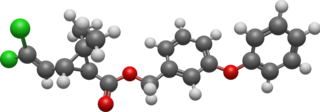Pyrethrum was a genus of several Old World plants now classified as Chrysanthemum or Tanacetum which are cultivated as ornamentals for their showy flower heads. Pyrethrum continues to be used as a common name for plants formerly included in the genus Pyrethrum. Pyrethrum is also the name of a natural insecticide made from the dried flower heads of Chrysanthemum cinerariifolium and Chrysanthemum coccineum. Its active ingredient are pyrethrins.

The pyrethrins are a class of organic compounds normally derived from Chrysanthemum cinerariifolium that have potent insecticidal activity by targeting the nervous systems of insects. Pyrethrin naturally occurs in chrysanthemum flowers and is often considered an organic insecticide when it is not combined with piperonyl butoxide or other synthetic adjuvants. Their insecticidal and insect-repellent properties have been known and used for thousands of years.

Bifenthrin is a pyrethroid insecticide. It is widely used against ant infestations, including the invasive red fire ant, by influencing its nervous system. It has a high toxicity to aquatic organisms.

A pyrethroid is an organic compound similar to the natural pyrethrins, which are produced by the flowers of pyrethrums. Pyrethroids are used as commercial and household insecticides.

Fenvalerate is a synthetic pyrethroid insecticide. It is a mixture of four optical isomers which have different insecticidal activities. The 2-S alpha configuration, known as esfenvalerate, is the most insecticidally active isomer. Fenvalerate consists of about 23% of this isomer.

Permethrin is a medication and an insecticide. As a medication, it is used to treat scabies and lice. It is applied to the skin as a cream or lotion. As an insecticide, it can be sprayed onto clothing or mosquito nets to kill the insects that touch them.

The allethrins are a group of related synthetic compounds used in insecticides. They are classified as pyrethroids, i.e. synthetic versions of pyrethrin, a chemical with insecticidal properties found naturally in Chrysanthemum flowers. They were first synthesized in the United States by Milton S. Schechter in 1949. Allethrin was the first pyrethroid.

Tetramethrin is a potent synthetic insecticide in the pyrethroid family. It is a white crystalline solid with a melting point of 65-80 °C. The commercial product is a mixture of stereoisomers.

Deltamethrin is a pyrethroid ester insecticide. Deltamethrin plays a key role in controlling malaria vectors, and is used in the manufacture of long-lasting insecticidal mosquito nets; however, resistance of mosquitos and bed bugs to deltamethrin is becoming widespread.

Tralomethrin is a pyrethroid insecticide.

Cyhalothrin is the ISO common name for an organic compound that, in specific isomeric forms, is used as a pesticide. It is a pyrethroid, a class of synthetic insecticides that mimic the structure and properties of the naturally occurring insecticide pyrethrin which is present in the flowers of Chrysanthemum cinerariifolium. Pyrethroids such as cyhalothrin are often preferred as an active ingredient in agricultural insecticides because they are more cost-effective and longer acting than natural pyrethrins. λ-and γ-cyhalothrin are now used to control insects and spider mites in crops including cotton, cereals, potatoes and vegetables.

Prallethrin is a pyrethroid insecticide. Prallethrin 1.6% w/w liquid vaporizer is a repellent insecticide which is generally used for the control of mosquitoes in the household.

Esfenvalerate is a synthetic pyrethroid insecticide marketed under the brand Asana. It is the (S)-enantiomer of fenvalerate.

Cyfluthrin is a pyrethroid insecticide and common household pesticide. It is a complex organic compound and the commercial product is sold as a mixture of isomers. Like most pyrethroids, it is highly toxic to fish and invertebrates, but it is far less toxic to humans. It is generally supplied as a 10–25% liquid concentrate for commercial use and is diluted prior to spraying onto agricultural crops and outbuildings.

Metofluthrin is a pyrethroid used as an insect repellent. The vapors of metofluthrin are highly effective and capable of repelling up to 97% of mosquitoes in field tests. Metofluthrin is used in a variety of consumer products, called emanators, for indoor and outdoor use. These products produce a vapor that protects an individual or area. Effectiveness is reduced by air movement. Metofluthrin is neurotoxic, and is not meant to be applied directly to human skin.

Tefluthrin is the ISO common name for an organic compound that is used as a pesticide. It is a pyrethroid, a class of synthetic insecticides that mimic the structure and properties of the naturally occurring insecticide pyrethrin which is present in the flowers of Chrysanthemum cinerariifolium. Pyrethroids such as tefluthrin are often preferred as active ingredients in agricultural insecticides because they are more cost-effective and longer acting than natural pyrethrins. It is effective against soil pests because it can move as a vapour without irreversibly binding to soil particles: in this respect it differs from most other pyrethroids.

Cyphenothrin is a synthetic pyrethroid insecticide. It is effective against cockroaches that have developed resistance to organophosphorous and carbamate insecticides.

Fenpropathrin, or fenopropathrin, is a widely used pyrethroid insecticide in agriculture and household. Fenpropathrin is an ingestion and contact synthetic pyrethroid. Its mode of action is similar to other natural (pyrethrum) and synthetic pyrethroids where in they interfere with the kinetics of voltage gated sodium channels causing paralysis and death of the pest. Fenpropathrin was the first of the light-stable synthetic pyrethroids to be synthesized in 1971, but it was not commercialized until 1980. Like other pyrethroids with an α-cyano group, fenpropathrin also belongs to the termed type II pyrethroids. Type II pyrethroids are a more potent toxicant than type I in depolarizing insect nerves. Application rates of fenpropathrin in agriculture according to US environmental protection agency (EPA) varies by crop but is not to exceed 0.4 lb ai/acre.
Michael Elliott, was a chemist and Lawes Trust Senior Fellow at Rothamsted Experimental Station who invented and commercialised the development of novel insecticides known as pyrethroids.
CYP6M2 is a gene location in Anopheles gambiae chromosome 3R, involved in the insecticide resistant. The enzyme encoded by this gene is capable of directly metabolizing pyrethroids, belongs to the cytochrome P450 family CYP6


















